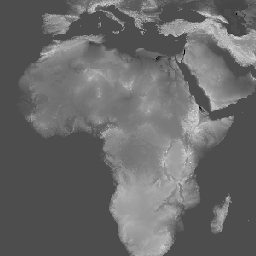AI-generated Key Takeaways
-
The Global Multi-resolution Terrain Elevation Data 2010 (GMTED2010) dataset provides global elevation data at 7.5 arc-seconds resolution, compiled from various sources including SRTM DTED data.
-
This dataset is available from 2010-01-01T00:00:00Z and is provided by the USGS.
-
The dataset includes bands for standard deviation, minimum, median, mean, maximum, sample, and breakline emphasis elevation, all measured in meters.
-
GMTED2010 replaces the GTOPO30 Elevation Model and its data is generally in the public domain for use without restriction.
-
The dataset can be explored and analyzed using Google Earth Engine.

- Dataset Availability
- 2010-01-01T00:00:00Z–2010-01-01T00:00:00Z
- Dataset Provider
- USGS
- Tags
Description
The Global Multi-resolution Terrain Elevation Data 2010 (GMTED2010) dataset contains elevation data for the globe collected from various sources at 7.5 arc-seconds resolution. More details are available in the dataset report.
The primary source dataset for GMTED2010 is NGA''s SRTM Digital Terrain Elevation Data (DTED®, https://www2.jpl.nasa.gov/srtm/) (void-filled) 1-arc-second data. For the geographic areas outside the SRTM coverage area and to fill in remaining holes in the SRTM data, the following sources were used: non-SRTM DTED®, Canadian Digital Elevation Data (CDED) at two resolutions, Satellite Pour l''Observation de la Terre (SPOT 5) Reference3D, National Elevation Dataset (NED) for the continental United States and Alaska, GEODATA 9 second digital elevation model (DEM) for Australia, an Antarctica satellite radar and laser altimeter DEM, and a Greenland satellite radar altimeter DEM.
This dataset replaces the GTOPO30 Elevation Model.
Bands
Pixel Size
231.92 meters
Bands
| Name | Units | Pixel Size | Description |
|---|---|---|---|
std |
m | meters | Standard Deviation |
min |
m | meters | Minimum |
med |
m | meters | Median |
mea |
m | meters | Mean |
max |
m | meters | Maximum |
dsc |
m | meters | Sample |
be75 |
m | meters | Breakline emphasis maintains the critical topographic features (streams or ridges) within the landscape by maintaining any minimum elevation or maximum elevation value on a breakline that passes within the specified analysis window. |
Terms of Use
Terms of Use
Most U.S. Geological Survey (USGS) information resides in the public domain and may be used without restriction. Additional information on Acknowledging or Crediting USGS as Information Source is available.
Citations
Global Multi-resolution Terrain Elevation Data 2010 courtesy of the U.S. Geological Survey
Explore with Earth Engine
Code Editor (JavaScript)
var dataset = ee.Image('USGS/GMTED2010_FULL'); var elevation = dataset.select('min'); var elevationVis = { min: -100.0, max: 6500.0, gamma: 3.5, }; Map.setCenter(17.93, 7.71, 2); Map.addLayer(elevation, elevationVis, 'Minimum Elevation');